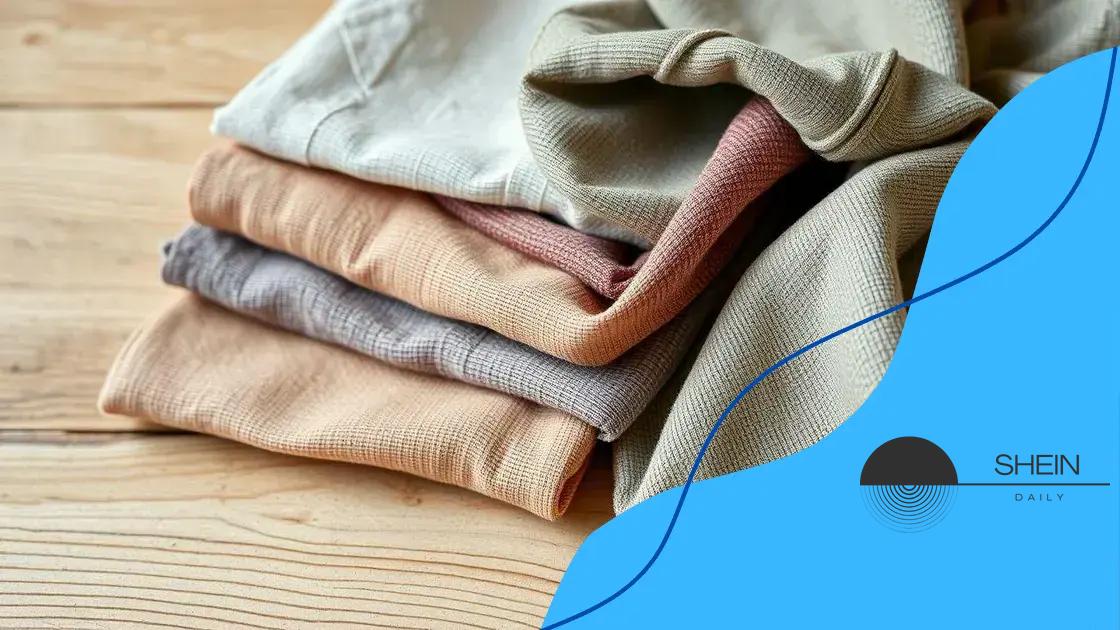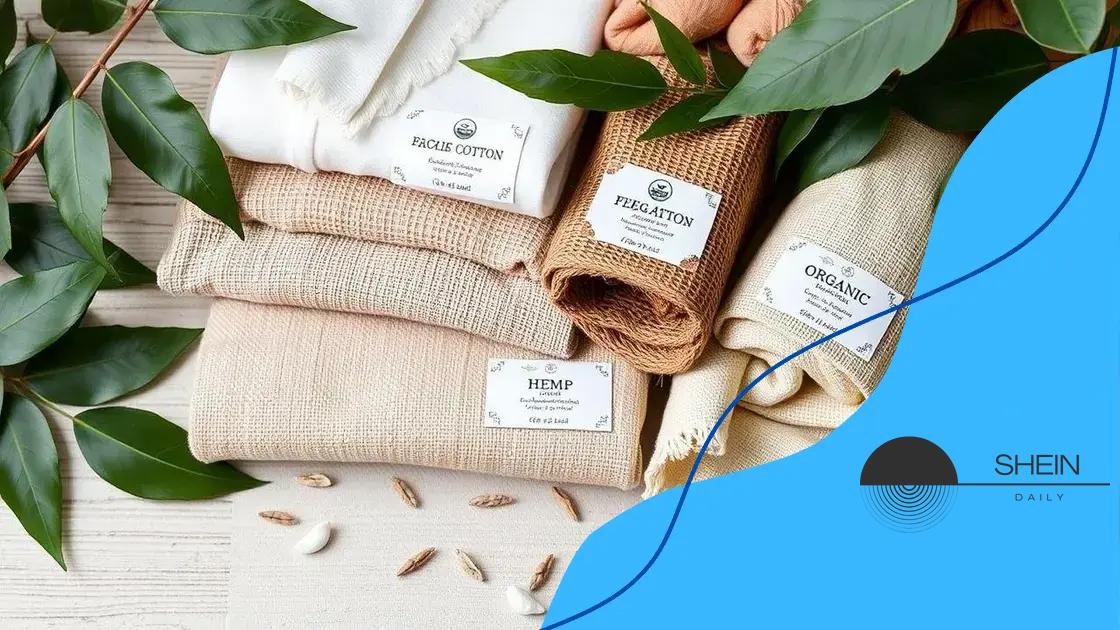Shein’s guides on choosing eco-friendly fabrics

Shein offers a variety of eco-friendly fabrics, including recycled polyester, organic cotton, hemp, and Tencel, allowing consumers to make stylish and sustainable fashion choices while reducing their environmental impact.
Shein’s guides on choosing eco-friendly fabrics offer valuable insights into making sustainable decisions for your clothing. Have you ever wondered how the fabric choices impact the environment? This article will explore the importance of eco-friendly materials and how they can make a difference.
Understanding eco-friendly fabrics
Understanding eco-friendly fabrics is vital for making conscious fashion choices. These materials not only contribute to a sustainable wardrobe but also help protect our planet.
What Makes a Fabric Eco-Friendly?
Several factors define eco-friendly fabrics. They are often made from natural fibers or recycled materials, reducing environmental impact. Some key characteristics include:
- Biodegradable: They break down naturally.
- Low chemical use: Fewer harmful substances are used in production.
- Sustainable sourcing: Materials are sourced without damaging ecosystems.
These qualities enhance their appeal and usefulness in sustainable fashion.
Why Choose Eco-Friendly Fabrics?
Choosing eco-friendly fabrics benefits both you and the environment. By opting for these materials, you contribute to reducing pollution and conserving resources. Furthermore, eco-friendly options often offer superior comfort and durability.
Many brands, like Shein, now provide eco-friendly choices. This makes it easier to find materials that align with your values. You can shop responsibly while enjoying trending styles.
Examples of Eco-Friendly Fabrics
- Organic Cotton: Grown without pesticides and chemicals.
- Hemp: Requires less water and no fertilizers.
- Bamboo: Grows rapidly and absorbs CO2.
- Recycled Polyester: Made from recycled plastics, reducing waste.
These alternatives empower consumers to make informed decisions about their clothing. Choosing them supports a cleaner, greener future.
As you consider your fabric choices, remember that every small action makes a difference. Embracing eco-friendly fabrics is a step towards sustainability.
The importance of fabric sustainability
The importance of fabric sustainability cannot be overstated. As the fashion industry grows, so does its impact on the environment. Understanding how our fabric choices affect the planet is vital for making responsible decisions.
Why Fabric Sustainability Matters
Sustainable fabrics are key to reducing waste and conserving resources. By choosing these materials, consumers play a role in minimizing pollution and protecting ecosystems. Every purchase can either contribute to or mitigate environmental harm.
- Saves natural resources: Sustainable fabrics often require less water and energy.
- Reduces carbon footprint: Eco-friendly practices lower greenhouse gas emissions.
- Supports ethical practices: Many sustainable options promote fair labor standards.
This connection between fabric sustainability and environmental health highlights the responsibility consumers have.
Impact on Wildlife and Ecosystems
The dyes and chemicals used in traditional fabric production can pollute waterways, harming aquatic life and disrupting ecosystems. Opting for sustainable fabrics helps preserve biodiversity and protect wildlife. Choosing organic or low-impact dyes can greatly reduce this pollution.
Furthermore, sustainable fabrics often come from renewable sources. Fabrics like hemp and organic cotton not only use fewer chemicals but also replenish soil nutrients. This natural cycle supports the environment rather than depleting it.
Consumer Awareness and Action
As consumers, being aware of the fabrics we buy is the first step towards change. By supporting brands that prioritize sustainability, we can encourage the industry to shift towards more eco-friendly practices. Simple actions like checking labels or researching brands can lead to more informed decisions.
Increasing demand for sustainable fabrics can lead to a positive chain reaction, promoting more environmentally-friendly practices in fashion. As you shop, consider how your choices can impact the world.
How to identify eco-friendly materials

Knowing how to identify eco-friendly materials is crucial for making sustainable fashion choices. Understanding the right labels, fabrics, and characteristics can help you select environmentally responsible clothing.
Look for Certifications
One of the most effective ways to identify eco-friendly materials is by checking for certifications. These certifications indicate that the fabric meets specific environmental standards. Some common certifications include:
- Global Organic Textile Standard (GOTS): Ensures organic fibers and sustainable processing.
- OEKO-TEX Standard 100: Certifies that the fabric is free from harmful substances.
- Fair Trade Certified: Promotes fair labor practices and sustainable crops.
These labels provide assurance that the materials are produced sustainably.
Assess the Fiber Types
Another way to identify eco-friendly fabrics is by looking at the fiber types. Some materials are inherently more sustainable than others. For example, fabrics like organic cotton, hemp, and linen are known for their lower environmental impact. On the other hand, synthetic fibers, such as polyester and nylon, often come from non-renewable resources and can be harmful to the environment.
Additionally, opt for fabrics created from recycled materials, such as recycled cotton or polyester made from plastic bottles. These options help reduce waste and lower your carbon footprint.
Check for Sustainable Sourcing
The sourcing of the textiles plays a key role in their sustainability. Research where the fabric comes from and the farming practices involved. Sustainable fabrics should come from farms that use minimal pesticides and water. Look for materials that are grown in a way that supports biodiversity and soil health.
Moreover, local sourcing is preferable because it reduces transportation emissions. Choosing local brands that prioritize sustainability helps strengthen communities while protecting the environment.
Watch for Environmental Impact
Finally, consider the overall impact of the production process. Eco-friendly materials should not only be sustainable but also created with minimal environmental harm. Investigate brands that focus on reducing their carbon footprint and chemical use during production.
By understanding these key aspects, you can more easily identify eco-friendly materials that align with your values and contribute to a sustainable wardrobe.
Top eco-friendly fabric options from Shein
When searching for eco-friendly fabric options, Shein offers various stylish choices to help you make sustainable fashion statements. Understanding the available materials is essential for making informed purchases.
1. Recycled Polyester
One of the standout options is recycled polyester, which is made from plastic bottles. By using discarded materials, this fabric helps reduce waste and minimizes the need for virgin polyester production. It’s durable, lightweight, and perfect for everyday wear.
2. Organic Cotton
Organic cotton is another popular choice at Shein. It is grown without harmful pesticides or synthetic fertilizers, benefiting both your skin and the environment. This fabric is soft and breathable, making it ideal for t-shirts, dresses, and loungewear.
3. Tencel (Lyocell)
Tencel is a fabric made from sustainably-sourced wood pulp. It is biodegradable and produced in a closed-loop process that recycles water and solvents. This eco-friendly option feels luxurious and drapes beautifully, making it suitable for various styles.
4. Linen
Linen is derived from the flax plant and is known for its low environmental impact. It requires minimal water and chemicals to grow. Additionally, linen is breathable and perfect for warm weather, making it a smart choice for summer wardrobes.
5. Hemp
Hemp fibers are sustainable and durable, providing a robust alternative to conventional fabrics. Hemp grows quickly and requires little water, making it an eco-friendly option. Shein’s offerings may include stylish hemp blends that are both chic and responsible.
By choosing these top eco-friendly fabric options from Shein, you can enjoy fashionable clothing while making a positive impact on the environment. Each choice reflects a commitment to sustainability, allowing you to express your style responsibly.
Tips for caring for eco-friendly garments
Caring for eco-friendly garments is essential to maintaining their longevity and sustainability. By following some simple tips, you can ensure that your eco-friendly fashion choices remain in great condition.
1. Wash with Care
When it comes to washing, always opt for cold water. Hot water can damage fibers and increase energy consumption. Use a gentle cycle to protect your garments and reduce wear and tear.
2. Choose Eco-Friendly Detergents
Select detergents that are free from harsh chemicals and fragrances. Eco-friendly options minimize pollution and are gentler on your clothes. Look for biodegradable soaps that will break down without harming the environment.
3. Air Dry Whenever Possible
Consider air drying your clothing instead of using a dryer. Hang garments on a line or lay them flat to dry. This method conserves energy and helps maintain the shape and integrity of the fabric.
4. Avoid Excessive Ironing
Inefficient ironing can lead to unnecessary energy usage and fabric damage. If your clothes need pressing, try using a steamer instead. It’s more gentle on the fibers and eliminates wrinkles effectively.
Pay attention to the care labels on your clothing, as they provide specific instructions for each fabric type. Following these guidelines helps your garments last longer and keeps your wardrobe sustainable.
Finally, remember to repair rather than discard. If you notice small tears or loose threads, mend them instead of throwing the garment away. This practice reduces waste and supports a more sustainable fashion culture.
FAQ – Frequently Asked Questions About Eco-Friendly Garments
Why should I choose eco-friendly fabrics?
Eco-friendly fabrics are better for the environment. They are made from sustainable materials that reduce pollution and conserve resources.
How can I care for my eco-friendly garments?
You can care for them by washing in cold water, using eco-friendly detergents, and air drying to maintain their quality.
What are some examples of eco-friendly materials?
Examples include organic cotton, recycled polyester, hemp, and Tencel, all of which have lower environmental impacts.
Can I find stylish clothing made from eco-friendly materials?
Yes, many brands, including Shein, offer trendy options made from eco-friendly fabrics.





